Queer & Now & Then: 1910-2009
In this biweekly column, Michael Koresky looks back through a century of cinema for traces of queerness, whether in plain sight or under the surface. Read the introductory essay.
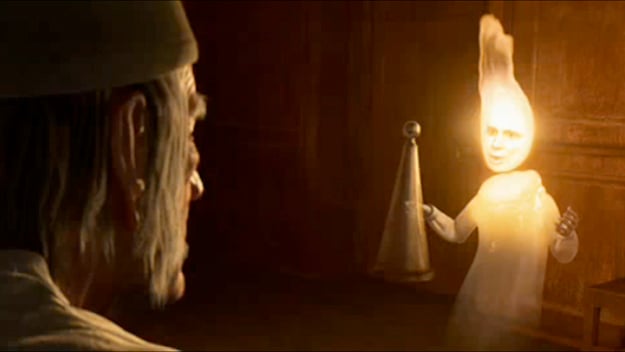
The spirit, as we all know, arrives at 1 a.m. It is described in a way that is entirely cinematic, five decades before cinema was born.
The ghost is “like a child: yet not so like a child as like an old man, viewed through some supernatural medium, which gave him the appearance of having receded from the view, and being diminished to a child’s proportions.” It is there and not there, as though cast from a projector or a magic lantern. It is all contradictions—neither young nor aged, and not anything in between; long, white hair yet no blemishes or wrinkles, with “the tenderest bloom on the skin.” Bare, delicate legs, but arms “very long and muscular.” The ghost embodies both summer and winter, holding fresh green holly in its hand yet bright summer flowers on its pure, white tunic. The ghost is only visible in the dark of the night because of the light thrown from its body, a brilliant illumination that could be put out, one suspects, from the large extinguisher cap it holds under its arm.
This strange being has come for Ebenezer Scrooge’s reclamation, the first of the three that had been foretold to the miser by the unwelcome specter of Jacob Marley earlier this Christmas Eve. This is, of course, Charles Dickens’s A Christmas Carol, the tale of a skinflint miser’s redemption into to a generous man of the world that was an instant sensation upon publication in 1843. It’s important to note that of all the spirits in Dickens’s original story, the Ghost of Christmas Past is the only one not to have been given literal shape by the book’s illustrator, John Leech. In his four original plates, the British caricaturist offered interpretations of the other ghostly characters: Marley, with his straight-backed posture, jaw-preserving bandage, and heavy chain luggage; the Ghost of Christmas Present, a jovial giant with a grin, an open robe, and broad hairy chest; and the Ghost of Christmas Yet to Come, a cloaked grim reaper, one insistent hand poking from its black cloth. They are all fairly straightforward, faithful drawings of the author’s descriptions, and have often been faithfully recreated on screen. As envisioned on the page by Dickens, though, the Ghost of Christmas Past is perhaps something that only a film camera—yet to be invented—might have been able to capture, if with a few tricks:
“As its belt sparkled and glittered now in one part and now in another, and what was light one instant, at another time was dark, so the figure itself fluctuated in its distinctiveness: being now a thing with one arm, now with one leg, now with twenty legs, now a pair of legs without a head, now a head without a body: of which dissolving parts, no outline would be visible in the dense gloom wherein they melted away. And in the very wonder of this, it would be itself again, distinct and clear as ever.”
The tale’s continued sturdiness as a foundational secular text and moral blueprint for western culture is reflected in the ceaseless outpouring of film and television adaptations. Yet the indeterminacy of the Ghost of Christmas Past remains one of its most defining, disrupting elements. The ever-fluctuating ways this character has been visualized, cast, and performed helps the story maintain a mystery and malleability all these years later. In his book Dickens and the Grown-Up Child, Malcolm Andrews devotes a section to this character, writing, “Though it has traces of some folkloric figures, such as the German Christkind [a specifically female incarnation of the Baby Jesus who brings Christmas tidings], it appears to be largely Dickens’s own invention.” Looking back through the years of screen adaptations, the Ghost is sometimes cast as a male, sometimes as a female, both on sliding scales between traditionally masculine and feminine; sometimes the Ghost is foregrounded as androgynous, and sometimes markedly without gender—this has at times been rationalized by making the Ghost a kind of seraphim. Dickens only left the barest of blueprints, as the brief “him/his” pronouns used at the character’s introduction soon dissolve away, leaving gender in the eye of the beholders: Scrooge, the filmmakers, and the viewers. It would be too much, perhaps, to make claims for the Ghost of Christmas Past as a properly, provocatively gender-less character, yet in its various filmic interpretations, we can see the differences in meaning made by presuming gender onto a character for whom it was purposely left out.
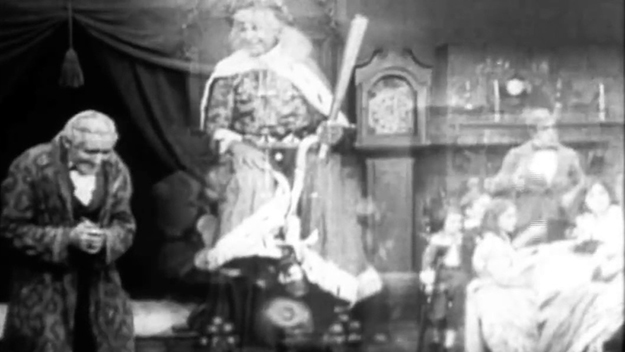
A Christmas Carol (J. Searle Dawley, 1910)
A Christmas Carol’s constant reappearance specifically in moving image art speaks to the visual possibilities afforded by Dickens’s supernatural tale: charting the various screen versions can also provide a fair evolution of advancements in the medium—photographic effects, color, animation, digitally generated imagery. After all, one of the first films of A Christmas Carol was produced by none other than the Thomas Edison Manufacturing Company, and the most recent high-profile theatrical version was made by one of our most technology-obsessed Hollywood practitioners, Robert Zemeckis. The almost exactly 100 years between these movies, made in 1910 and 2009, respectively, features a wealth of incarnations, each with its own creative solutions for manifesting Dickens’s spirit world while reminding new generations of the power of his central message of social welfare. In terms of the Ghost of Christmas Past, visual effects are employed to make tangible a character who is by necessity indistinct.
Dickens’s dialogue is so evocative that one of the pleasures of each new adaptation is the chance to hear how newly cast actors will deliver lines like Marley’s “Mankind was my business!” or Scrooge’s “If I had my way, every idiot who goes about with ‘Merry Christmas’ on his lips would be boiled with his own pudding…” So it’s fascinating to watch the 13-minute Edison version, mostly to see how a story known for its words is reduced to a series of pictures. As was often the case at such an early stage of cinema, this silent film is predominantly a series of static tableaux, here centered on a modest number of flimsy-looking sets meant to evoke Scrooge’s counting house, bed chambers, and a London street. The story would have been so well-known that just the barest hint of inter-title context is necessary; thus when the Ghost of Christmas Past shows up, in a sharp cut immediately following Marley’s visit, all that is provided is a fleeting card stating “The Spirit of Christmas recalls incidents of his youth and early manhood.” Most fascinating about this first of the three spirits, achieved convincingly as a photographic superimposition, is that I genuinely cannot tell if the character is being portrayed by a man or a woman. Hovering a bit above Scrooge, the benevolent, smiling Ghost appears with long, curly white hair, wearing a long, loose robe and a crown of holly; in a rather beautiful composition, the Ghost stretches out an arm while behind it the drama of Scrooge’s childhood and apprenticeship at Fezziwig’s plays out in a series of impressions, an excellent use of double-exposure to get the most out of the film’s necessary single-setting. In another example of imaginative visual consolidation, the same actor returns as the subsequent ghosts, implying this already malleable holiday spirit lives at once in the past, present, and future.
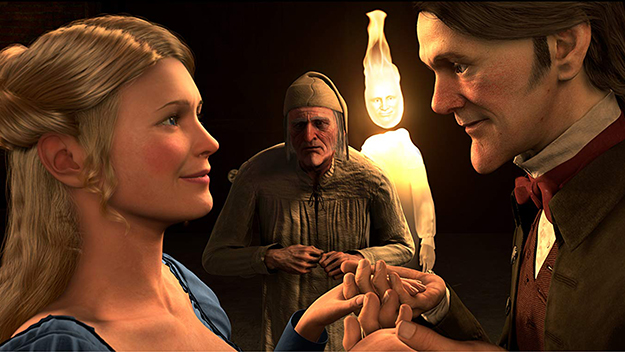
A Christmas Carol (Robert Zemeckis, 2009)
Whereas the 1910 version seemed to employ Dickens’s popular narrative as a vessel to show off a host of visual tricks possible in a very young medium, Zemeckis’s 2009 version was largely taken as an excuse by the director to continue pushing new cinematic techniques on the public, in this case digital motion-capture animation. Always on the vanguard of visual effects advancements, as evident in his Oscar-winning Who Framed Roger Rabbit?, Death Becomes Her, and Forrest Gump, Zemeckis had, as the new century unfolded, been enraptured by this new form, which he had already used for such big-budget experiments as The Polar Express, an adaptation of Chris Van Allsburg’s beloved holiday children’s book, and Beowulf, an attempt to invigorate musty schoolroom literature, in this case a tenth-century Old English text set in Scandinavia. Zemeckis’s A Christmas Carol splits the difference between those, though the motion capture technique still resulted in a form of animation regularly criticized for reducing actors’ vigorous vocal and physical performances to a series of mechanical movements from what look like plastic, dead-eyed zombies.
A major exception to this rule is the splendid evocation of the Ghost of Christmas Past, here designed as kind of anthropomorphized candle, its head a detached flame, floating above its shoulders and given to stutters that register as burning flickers. The effect was particularly startling and enveloping upon the film’s original theatrical release in 3D, as it seemed to flare up the binoculars’ peripheral vision when the character’s ball of fire head would fill up particular parts of the frame. As played by Jim Carrey—for whom motion-capture afforded the ability to play not only old and young Scrooge, but also all three spirits—the Ghost whispers in an Irish lilt, an inexplicable, distracting regional specificity; otherwise, it’s a spectacularly disembodied creation, its vertical, waxen body resembling a nightgown all but disappearing into ether below the shoulders. This incarnation of the Ghost is itself a kind of invocation, an illuminating reminder of its essential immateriality.
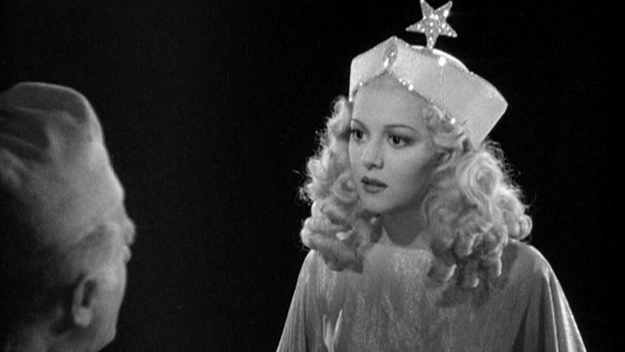
Ann Rutherford in A Christmas Carol (Edwin L. Marin, 1938)
The Ghost of Christmas Past is, like the other spirits, an oracle, yet its ability to plumb the depths of Scrooge’s past grants this character particular psychological power over Dickens’s antihero. The Ghost, after all, is the only one whose truths become so unbearable that Scrooge actually snuffs out its life force, sending the Ghost away—and ending the book’s second “stave”—by placing the extinguishing cap on its head. It’s an essential character, yet an emotionally opaque one, and, depending on the actor’s interpretation, either very much enjoys torturing Scrooge with memories of his past vices and misdeeds or has come to lend a sympathetic ear.
Each embodiment of the Ghost reveals something essential about the tone of the overall adaptation. In fact, it’s a fair estimation of a given film’s relative strength of vision just how this Ghost is depicted—for instance, whether and why certain adaptations have chosen to make the character distinctly female. In the anodyne and severely truncated 1938 MGM version with Reginald Owen, the Ghost is played by Ann Rutherford as a beseeching blonde angel in a shimmering dress, a kind of proto Glinda the Good Witch. In a 1954 live television adaptation for the Desilu-produced variety show Shower of Stars, featuring Fredric March as Scrooge and original songs by Bernard Herrmann, the Ghost is played by blooming lass Sally Fraser, who interestingly also doubles as Scrooge’s lost love, Belle. In 1970’s almost entirely camp musical version, directed by Ronald Neame and starring a deranged Albert Finney, the Ghost is inhabited by an imperious Dame Edith Evans—a woman of regal bearing, she is unambiguously a flesh-and-blood woman, making a grand entrance in an imposing red dress, her hands hidden in a posh muff. In the 1984 TV movie—my own personal favorite, for the sheer unsentimental force of George C. Scott’s galvanizing portrayal of Scrooge—the Ghost is played by English stage actress Angela Pleasence with a punkish glint in her eye and a spiky blonde Bowie ’do. She’s the perfect Ghost for this grimy, gritty, fog-enshrouded version; when Scrooge tries to boast about his financial accomplishments to her, she responds “Congratulations” with a disconcertingly sarcastic sneer.
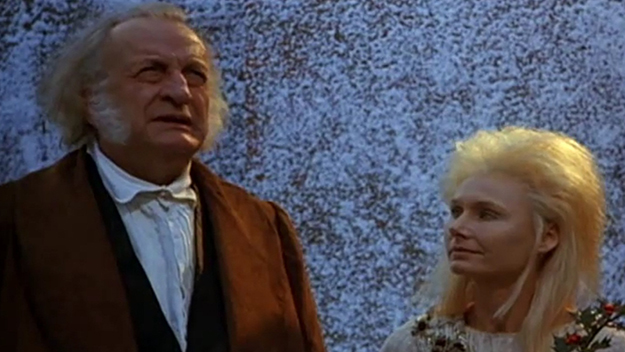
George C. Scott and Angela Pleasence in A Christmas Carol (Clive Donner, 1984)
In the versions listed above, the Ghost of Christmas Past inhabits either untouchable angel or impossible-to-please mother figure. In those where the Ghost is cast more as recognizably male, it becomes less distinct; without traditionally “female” qualities, its gender is neutralized. In the 1935 film, famous for starring the stage’s most legendary Scrooge, Seymour Hicks—who also appeared in a 1913 British silent version that doesn’t even feature the three spirits, opting for just Marley—the Ghost appears as just a white, glowing silhouette hovering in his bedchambers, though an authoritative male voice booms from its formless outline, giving it the sense of being a kind of punishing, avenging demon. The beloved 1951 British version, directed by Brian Desmond Hurst and starring Alastair Sim, features a reassuringly saintly little old man with flowing white hair, played by Irish actor Michael Dolan, whose unthreatening, avuncular manner recalls another recent cinematic Christmas angel, the cherubic Clarence from It’s a Wonderful Life (1946), though without Henry Travers’s shadings of wit and mildly subversive tendency to flirtation (Clarence is perhaps one of American cinema’s great stealth queer characters, after all). And then there’s the truly bizarre decision in Richard Donner’s 1988 Scrooged, with Bill Murray, to cast caterwauling David Johansen— Buster Poindexter himself—as a cab-driving, cigar-chomping Ghost, undoubtedly the most über-masculine rendition, an earthy man of the working class who has little time or patience for the improprieties of his wealthy charge.
The past is vague, indefinable, so Dickens left this Ghost as hazy as memory itself. Readers—and, as it turned out, future artists and filmmakers—have thus been allowed to project onto it, define its parameters. Perhaps the incarnation that makes the most sense—and the only one that can hold a candle to Zemeckis’s version for its otherworldly, shivery beauty—is in Richard Williams’s gorgeously eerie, chalky 1971 Oscar-winning animated short. It’s a fully androgynous visualization, featuring a melancholy, husky-voiced Diana Quick as the sad-eyed Ghost, who pulsates in and out of materiality, looking and sounding somehow at once ancient and newborn, strong and frail, female and male. The hand-drawn style of this version allows for a literal sketchiness, so that the spirit looks perpetually half-formed. It’s a fully convincing evocation of Dickens’s description of a character eternally in the process of becoming.
Michael Koresky is a writer, editor, and filmmaker in Brooklyn. He is cofounder and editor of the online film magazine Reverse Shot, a publication of Museum of the Moving Image; a regular contributor to the Criterion Collection and Film Comment, where he writes the biweekly column Queer and Now and Then; and the author of Terence Davies, published by University of Illinois Press, 2014.







